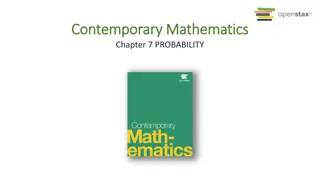Laboratory Experiments on Geotechnical Properties
This instructional guide outlines laboratory procedures for determining geotechnical properties such as dynamic angle of repose, static coefficient of friction, surface area of fruits, and screening for ground feed classification. It includes steps, apparatus required, calculations, and questions to enhance understanding.
Download Presentation

Please find below an Image/Link to download the presentation.
The content on the website is provided AS IS for your information and personal use only. It may not be sold, licensed, or shared on other websites without obtaining consent from the author.If you encounter any issues during the download, it is possible that the publisher has removed the file from their server.
You are allowed to download the files provided on this website for personal or commercial use, subject to the condition that they are used lawfully. All files are the property of their respective owners.
The content on the website is provided AS IS for your information and personal use only. It may not be sold, licensed, or shared on other websites without obtaining consent from the author.
E N D
Presentation Transcript
their definitions have been given in the class. Revise these definitions in order to get a clear distinction between these two properties. PROCEDURE 1.DYNAMIC ANGLE OF REPOSE You are supplied with two types of agricultural crops. Follow the instructions of the laboratory supervisor and use the funnel system to determine the angle of repose. You are also supplied with an emptying angle box. Use this method in obtaining the angle of repose. Compare your results. Which of these values for these crops? 1.STATIC COEFFICIENT OF FRICTION (i) You are supplied with an inclined plane method apparatus. Following the instructions of the laboratory supervisor, coefficient of friction on plywood (along the grain) plywood (across the grain) galvanized iron sheet C. ANSWER THE FOLLOWING QUESTIONS: 1.Under what real-life situations would you think angle of repose and angle of internal friction are useful? 2.Under what situations do you think: a high angle of repose is an advantage? determine the static
APPARATUS: Planimeter, plain paper, pencil and ruler NOTES: A planimeter is an instrument for measuring the area of all shapes of plane figure. The area is obtained by tracing their perimeters. Area of plans and maps to any scale, sectional areas of machine drawings as well as the mean heights of line diagrams can also be otained with the panimeter. PROCEDURE A. GETTING FAMILIAR PLANIMETER The laboratory instructor will explain to you how the panimeter isused Sketch and label the various parts of the planimeter Explain in your own words how the planimeter is set up and used. B. TEST-RUNNING THE PLANIMETER A.Attach the test rule as described to you. Set the planimeter as directed and determine the area described inmm2 2. Find the percent difference between your measurement and the area of the square. 3. Draw a square of 1 x 1cm and use the planimeter to determine the area of the square. Repeat for a circle of 1cm diameter. 4 Find the percentage error. ANSWER THE FOLLOWING QUESTIONS 1. What are the advantages and disadvantages of using a planimeter for area determinations WITH THE
Draw the smallest circumscribing circle on the projection drawn in (1) Use both planimeter and graph sheet method to determine the projected area Ap and the circumscribing circle A2 Determine Roundness (Ap / Ac) with both methods Compare your answers for the three products 1.SURFACE AREA OF FRUITS Your are supplied with two kinds of fruits/seeds 1.Coat each fruit/seed with the ink supplied 2.Cover the entire fruit/seed with graph paper (You may fold the graph paper) 3.Use the graph paper squares to determine the surface area of each fruit/seed. 4.Use the planimeter to determine the surface area of the fruit/seed. 5.Compare your results. D. Answer the following questions: 1. What specific advantages to do you think (a) the planimeter has over the graph paper method? (b) the graph paper method has over the planimeter? 2. Which method will you choose and why if: (a) you are in the field
Fineness modulus and modulus of uniformity are two indices that are used to classify ground feed. These indices have been explained to you in the classroom. PROCEDURE: 1.SCREENING You have been supplied with two samples A.Grains B.Ground feed Weigh 250g of each sample Arrange the seven standard sieves (3/8 4, 8, 14, 28, 48, 100) and the pan on the Ro-tap, pour the sample from the top and vibrate for 5 minutes. Find the percentage on each sieve 1.CALCULATIONS A.Using an appropriate table, calculate the fineness modulus (fm) B.Calculate the average size of grain (D) in inches. D = 0.0041 x 2fm (iiI) Determine the modulus of elasticity Draw a graph of screen opening versus percent finer than screen. 1.ANSWER THE FOLLOWING QUESTIONS i) In what category will you place your two samples in terms of course, medium and finer in relation to; Fineness Modulus Modulus of uniformity























